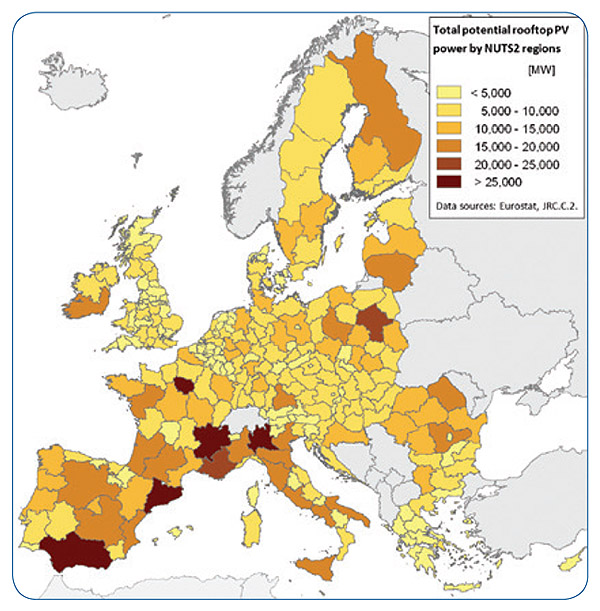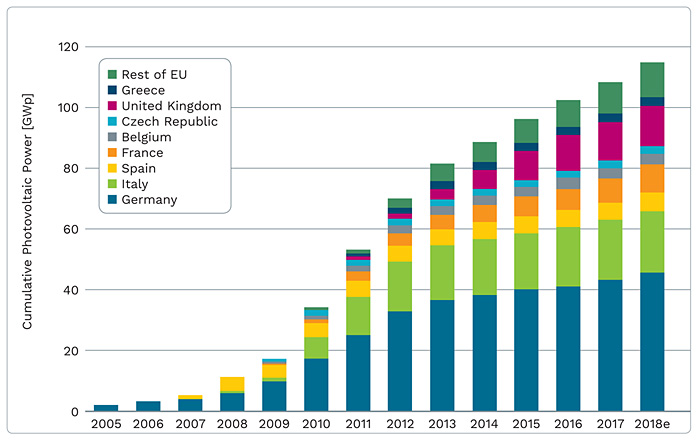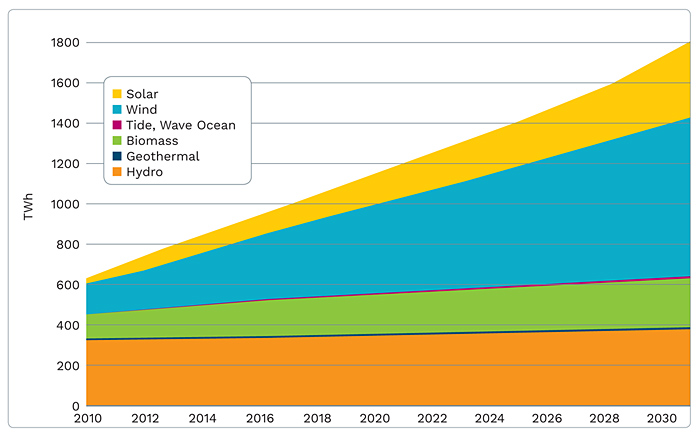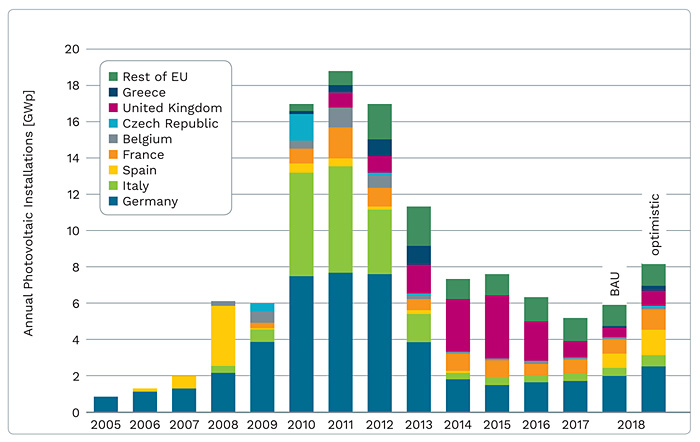Benefits for the climate and local economies
 The necessity to limit the maximum global average temperature rise as close as possible to 1.5°C was acknowledged with the Paris Agreement, which went into force on 4th November 2016. However, the current policies in place to limit global greenhouse gas (GHG) emission are still not sufficient to keep the temperature rise below 2°C[1]. The burning of fossil fuels for energy purposes is still the largest source of the world's greenhouse gas emissions with 68%, making the decarbonisation of our energy supply the single most important component to achieve the targets[2, 3]. World-wide, the power sector was responsible for 38% of the fossil fuel related and 31% of the total CO2 emissions, even as electricity accounted only for 18.5% of the final energy consumption in 2015. Despite the progress to increase renewable power generation, the total emissions related to the generation of electricity have increased by 45% compared to a 40% total increase of CO2 emissions between 2000 and 2015[3].
The necessity to limit the maximum global average temperature rise as close as possible to 1.5°C was acknowledged with the Paris Agreement, which went into force on 4th November 2016. However, the current policies in place to limit global greenhouse gas (GHG) emission are still not sufficient to keep the temperature rise below 2°C[1]. The burning of fossil fuels for energy purposes is still the largest source of the world's greenhouse gas emissions with 68%, making the decarbonisation of our energy supply the single most important component to achieve the targets[2, 3]. World-wide, the power sector was responsible for 38% of the fossil fuel related and 31% of the total CO2 emissions, even as electricity accounted only for 18.5% of the final energy consumption in 2015. Despite the progress to increase renewable power generation, the total emissions related to the generation of electricity have increased by 45% compared to a 40% total increase of CO2 emissions between 2000 and 2015[3].

Figure 1: Potential PV capacity per NUTS2 region[11]
To meet the targets of the Paris Agreement, CO2 emissions from the power sector have to decrease to 65g CO2/kWh by 2050 from 506g in 2015[3,4]. This is a huge task and can only be realised under the Sustainable development Scenario of the IEA's World Energy Outlook 2017. For Europe the challenge is even bigger as electricity emissions in Europe should decrease to 45g CO2/kWh by 2050.
Recent 100% renewable electricity scenarios have highlighted the importance of solar photovoltaics to achieve this goal and decarbonise the power sector in a cost effective manner. To realise a carbon free power supply by 2050 the installed PV generation capacity of about 400GW at the end of 2017 hast to increase to more than 4TW by 2025 and 21.9TW by 2050 to make it happen[5,6].
What options are available to install the required capacity?
- a) Large-scale or utility plants, with arrays of free-standing modules, connected to the transmission grid.
- b) Dual use of traffic or water infrastructure[7,8], closed landfills [9] and the re-naturalisation of mining sites offer potentials, often in the perimeter of existing electricity infrastructure.
- c) PV located on roofs or facades of buildings.
The different options have different economic rationales. Utility PV plants can take advantage of economies of scale to reduce investment and operational costs, and the electricity generated can be traded in wholesale markets.
Dual use systems can have higher capital costs, but this can partially be offset by the additional value, the system provides, like the reduction of water evaporation, noise barriers, lower infrastructure costs or local employment.
Rooftop installations have higher capital costs, but the electricity can be consumed either wholly or in part on site, so the value is related to the relevant industrial or residential retail prices. Rooftop PV also brings a better geographical match between supply and demand, a factor of increasing importance as we progressively electrify the heating and cooling and the transport sectors.
Several studies suggest that roof space is not an issue, even for the most ambitious scenarios. For instance the IEA 2016 Energy Technology Perspectives reports an estimate for PV potential in EU urban areas of over 500GW and 4,350GW worldwide by 2030[10].
Like many other EU-wide studies the IEA relies entirely on population density data as a proxy. In order to use a more direct approach and to map actual buildings right across Europe using earth observation data, the Joint Research Centre performed a study exploiting data from the Global Human Settlement Layer (GHSL) initiative. With this it is possible to estimate available rooftop area in blocks of 10m X 10m across the entire EU in both urban and rural areas. Calculations on NUTS2 level show that if the suitable rooftop area is used for PV generation this could result in more than 680 and up to 1,500TWh of electricity generation depending on different assumptions
of other competing rooftop uses[11,12] (Figure 1). This would require about 600 to 1,200GW of installed PV power compared to the roughly 115GW to be reached at the end of 2018 (Figure 2)[5].

Figure 2: Cumulative installed PV power capacity between 2005 and 2018

Figure 3: European electricity production until 2030 to meet the 32% RES target (extrapolation based on the
impact assessment of the 2016 Market Design Directive proposal[5]).
During the recast of the Renewable Energy Directive (2009/28/EC), a political agreement on increasing renewable energy use in Europe was reached between negotiators from the Commission, the European Parliament and the Council on 14 June 2018. The agreement sets a new, binding, renewable energy target for the EU for 2030 of 32%, including a review clause by 2023 for an upward revision of the EU level target[13].
As a consequence, renewable electricity would have to contribute roughly 65% of the final energy demand with around 1,200 to 1,250TWh to be generated from solar and wind power (Figure 3). Of this roughly 400TWh would come from solar power, about 20TWh Solar Thermal Power Generation and 380TWh PV, which would require close to 350GW PV capacity to be installed by 2030, about three times the capacity of 2018.
However, with a total installed capacity of about 115GW at the end of 2018 and annual installations between 5.1 and 7.5GW in the last four years (Figure 4), it will be difficult to reach this target[5]. New policies are needed to enable a three times larger annual market over the next 13 years, which is needed to reach the target.
"To deliver the Paris Agreement, PV power capacity in the EU has to triple until 2030."
"The dependency of the European Union
on energy imports has increased from about 40% of gross energy consumption to 54% between 1990 and 2015."
The dependency of the European Union on energy imports has increased from about 40% of gross energy consumption to 54% between 1990 and 2015[14]. In 1990 renewable energy contributed about 4.5% and increased to more than 13.2% in 2015. Without this tripling of local generated renewable energy the
energy dependency would have exceeded 60%. The annual value of the energy imports amount to more than €400 billion, which values the renewable energy at about €100 billion[15].

Figure 4: The annual photovoltaic installations in the European Union
In a recently published Opinion, the European Economic and Social Committee highlighted some effects of a decentralised renewable energy supply on jobs and regional economies[15]. Especially regions with no or little own fossil energy resources, which have to spend significant amounts for the import of the needed energy, decentralised local renewable can make a significant impact in local wealth creation. Self-consumption of electricity from PV systems in the Podlaskie region, Poland, is one of the examples highlighted to boost regional purchasing power.
How can the great potential of PV systems on rooftops be utilised and help to deliver the Paris agreement?
One of the problems is that so far, self-consumption in most countries has been limited to the owners or tenants of single family homes or small PV systems in apartment buildings. However, the rooftops of multi-apartment buildings or office buildings with multiple ownership represent a large share of the total available rooftop. Until now this is widely untapped for self-consumption of commonly generated PV electricity. Despite the fact that new economic concepts of PV system use in such buildings have gained momentum over the last two years, the existing different administrative provisions as well as technical regulations end electricity codes for self-consumption in such buildings make the implementation highly complicated. In a recent study, the current situation of nine different countries in IEA PVPS Task14 was shown[16]. The main obstacle for a wide spread uptake of PV generated electricity with selfconsumption are not of technical nature, but regulatory ones.
Increased self-consumption of PV electricity can help to accelerate the transition to a decarbonised electricity system and the utilisation of apartment roofs for PV installations play an important role to reach this goal. To enable the participation of people living in these buildings, appropriate regulatory and legal conditions, which enable a secure and fair financing of the necessary grid infrastructure and providing economic benefits for residential PV system operators and society are necessary. Community initiatives and
political de-risking instruments are crucial.
Last but not least, the Energy Performance of Buildings Directive (2018/844/EC) and the increasing requirements for net zero energy buildings is another driver. The JRC estimates that approximately 1.5 million new residential buildings are constructed per year, and 2.5 million undergo substantial renovation. Adding only 10m2 PV to each project would potentially add 5.7GW per year. With commercial buildings even more dynamic and the addition of retrofitting existing buildings the potential for PV to contribute significantly to the Paris Goals and the local economies are clearly viable.
The scientific output expressed is based on the current information available to the author, and does not imply a policy position of the European Commission.
Contact information
Dr. Arnulf Jäger-Waldau
Email: arnulf.jaeger-waldau@ec.europa.eu
Web: ec.europa.eu/jrc/en/research-topic/photovoltaics
[1] Watson R, Carraro C, Canziani P, Nakicenovic N, McCarthy JJ, Goldemberg J and Hisas L. The Truth About Climate Change, September 2016, ISBN 978-0-
9831909-1-2
[2] International Energy Agency, 2017, Key World Energy Statistics 2017
[3] International Energy Agency, CO2 Emissions from Fuel Combustion, October 2017, ISBN 978-92-64-27819-6 ISSN 2219-9446
[4] International Energy Agency, World Energy Outlook 2017, ISBN: 978-92-64-28230-8
[5] Jäger-Waldau, A., Snapshot of Photovoltaics 2018, EPJ Photovoltaics 9, 6 (2018)
[6] Breyer Ch, Bogdanov D, Aghahosseini A, Gulagi A, Child M, Solomon Oyewo A, Farfan J, Sadovskaia K, Vainikka P, Solar photovoltaics demand for the global
energy transition in the power sector, Prog Photovolt Res Appl. 2017; 1–19, DOI: 10.1002/pip.2950r
[7] Kougias I, Bódis K, Jäger-Waldau A, Monforti- Ferrario F, Szabó S,. Exploiting existing dams for solar pv system installations. Progr Photovolt: Res Appl.
2016;24(2):229–39
[8] Kougias I, Bódis K, Jäger-Waldau A, Moner-Girona M, Monforti-Ferrario F, Ossenbrink H, et al., The potential of water infrastructure to accommodate solar
pv systems in mediterranean islands. Sol Energy 2016; 136:174–82
[9] Szabo S, Bódis K, Kougias I, Moner-Girona M, Jäger-Waldau A, Barton G, Szabó L, A methodology for maximizing the benefits of solar landfills on closed
sites, Renewable and Sustainable Energy Reviews 76 (2017) 1291–1300
[10] International Energy Agency, Energy Technology Perspectives 2016, Annex H: Rooftop Solar PV Potential in Cities, ISBN PRINT 978-92-64-25234-9 / PDF
978-92-64-25233-2
[11] Huld Th, Bodis K, Pinedo Pascua I, Dunlop E, Taylor N, Jäger-Waldau A, "The Rooftop Potential for PV Systems in the European Union to deliver the Paris
Agreement", European Energy Innovation, Spring 2018, 12-15 p
[12] Jäger-Waldau A., Huld Th, Bódis K and Szabo S, Photovoltaics in Europe after the Paris Agreement, Proceedings of the 7th World Conference on
Photovoltaic Power Conversion, June 2018, Waikaloa, USA
[13] European Commission statement/18/4155, 14 June 2018 (http://europa.eu/rapid/press-release_STATEMENT-18-4155_en.htm)
[14] Eurostat, statistics explained: Energy production and imports, June 2017, http://ec.europa.eu/eurostat/statistics-explained/pdfscache/1216.pdf
[15] European Economic and Social Committee, TEN/660, The effects of a new carbon-free, decentralised and digitalised energy supply structure
[16] Jäger-Waldau A, Bucher Ch, Frederiksen KHB., Guerro-Lemus R, Masson G, Mather B, Mayr Ch, Moneta D, Nikoletatos J and Roberts MB, Self-consumption
of electricity produced from PV systems in apartment buildings - Comparison of the situation in Australia, Austria, Denmark, Germany, Greece, Italy,
Spain, Switzerland and the USA, Proceedings of the 7th World Conference on Photovoltaic Power Conversion, June 2018, Waikaloa, USA